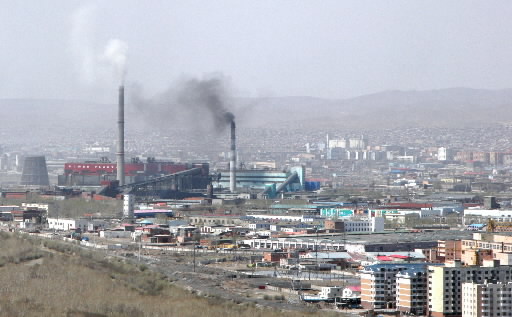Nuclear weapons can be eliminated: Chapter 3, Part 3
Jun. 21, 2009
Chapter 3: Mongolia's challenge
Part 3: Uranium resources
by Keisuke Yoshihara, Staff Writer
The nation constructs its first nuclear power plant
In late April, “The Mongol Messenger,” an English language weekly magazine, carried a picture on the front page in which Sanjaa Bayar, prime minister of Mongolia, and Mohamed ElBaradei, director general of the International Atomic Energy Agency (IAEA,) were posing with a firm handshake. The accompanying headline leapt out from the page: “IAEA supports Mongolia.”
The article is about Mongolia’s nuclear power plant construction project. A national undertaking, the country plans to construct an experimental reactor by 2015, paving the way for the peaceful use of nuclear energy. The project is said to be envisioned as an environmentally-favorable means of securing energy for the nation.
A thermal power plant is located at a site roughly four kilometers to the southwest of downtown Ulaanbaatar, the capital of Mongolia. This is approximately the halfway point between the city center and the Chinggis Khaan International Airport. The plant uses domestic coal and billows out black smoke. A total of seven similar thermal power plants are operating in the country.
“Coal is cheap, but if the costs of pollution countermeasures are factored in, nuclear power is cheaper. And Mongolia has uranium, the resource for nuclear power,” said Sodnom Enkhbat, 54, director general of the Nuclear Energy Agency, expressing high hopes for the nation’s first nuclear power plant.
Mongolia abounds in natural uranium reserves, which can be used as material for nuclear weapons as well as nuclear power. A joint exploration conducted with the former Soviet Union in the 1980s revealed that the amount of uranium deposits is estimated between 63,000 tons and 73,000 tons, making it the 13th to 15th largest national stock of uranium in the world. At the same time, based on geological research, some believe that Mongolia is blessed with 1 million tons of uranium, ranking it within the world’s top five.
Mining, with the cooperation of the IAEA, will start as early as next year. At present, the Mongolian government is developing the nation’s basic policy and the draft legislation on the use of nuclear power. Mr. Enkhbat stressed, “Our nuclear power will absolutely be used for peaceful purposes. In 2000 we enacted a law where the development, possession, and transit of nuclear weapons through our territory are prohibited. We also signed an additional protocol with the IAEA, pledging to undergo IAEA inspections.”
For the moment, no campaign has emerged to oppose the commercial use of nuclear power. Rather, some point out that Mongolia’s challenge is to raise awareness in regard to radiation. An official at the Mongolian Branch of the International Physicians for the Prevention of Nuclear War (IPPNW) said that a man in his 30s was arrested after bringing back uranium ore from a uranium mine and hid it under his bed with the intention of selling it.
After the incident, the IPPNW branch, led by young doctors, translated the book One Day in Hiroshima--An Oral History into Mongolian. Written by Nanao Kamada, a doctor and the board chairman of the Hiroshima A-Bomb Survivors Relief Foundation, the book is a practical guide to the effects of radiation on the human body and the damage wrought by the atomic bombing. But due to a lack of funds, the group has had to suspend its plan to publish the book, which would cost some 1 million yen for 2,000 copies.
“In Mongolia, a popular song called ‘Paper Cranes’ has become a big hit and people are familiar with the atomic bombing of Hiroshima,” said Dr. Sodnomdarjaa Oyuntsetseg, 50, a member of the IPPNW branch. “But the radiation damage is not so widely known. That’s why we’d like to publish the book now.”
(Originally published on June 3, 2009)
To comment on this article, please click the link below. Comments will be moderated and posted in a timely fashion. Comments may also appear in the Chugoku Shimbun newspaper.








